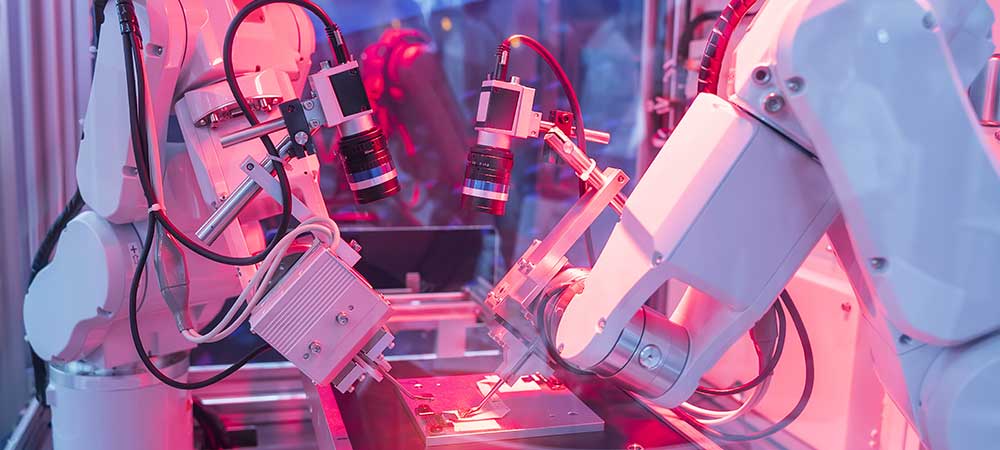Artificial Intelligence improves business capabilities in various ways. Adnan Masood, PhD., Chief Architect – AI / ML at UST, explains how AI is utilised in the manufacturing industry and the benefits it brings to organisations such as transforming operations and reducing costs.
What benefits does AI bring to manufacturing?
As a collective and sometimes rather omniscient term, Artificial Intelligence (AI) includes the capabilities of learning systems that are perceived as intelligent by humans. AI and Machine Learning (ML) technologies have become top priorities in manufacturing since they allow firms to alter business models, invent operational paradigms to support those models, and monetise information to achieve higher levels of productivity.
Beyond hypes and fads, AI works because it amasses significant benefits for the manufacturing sector, such as enabling smart production, developing predictive and preventative maintenance, offering supply chain optimisation, improved safety, product development, and optimisation, facilitating AR/VR (Augmented and Virtual Reality), cost reduction, quality assurance and enabling green operations (energy management), to name a few. AI enablement is most commonly used by manufacturing industries to increase overall equipment efficiency and yield. AI is also being utilised generally as a tool to improve productivity, quality and consistency, which helps manufacturers forecast more accurately.
It’s safe to say that the manufacturing industry continues to be driven by AI and ML technologies. UST has observed the critical use of AI in transforming operations, improving product quality and reducing costs through various methods including smart operation, design prediction, quality assessment of products and more.
Why is the adoption of AI in manufacturing accelerating?
There are few key advantages which make the adoption of AI particularly suitable as launching pads for manufacturers to embark on their cognitive computing journey – intelligent maintenance, intelligent demand planning and forecasting, and product quality control.
The deployment of AI is a complex process, as with many facets of digitisation, but it has not stopped companies from moving forward. The ability to grow and sustain the AI initiative over time, in a manner that generates increasing value for the enterprise, is likely to be crucial to achieving early success milestones on an AI adoption journey.
Manufacturing companies are adopting AI and ML with such speed because by using these cognitive computing technologies, organisations can optimise their analytics capabilities, make better forecasts and decrease inventory costs. Improved analytics capabilities enable companies to switch to predictive maintenance, reducing maintenance costs and reducing downtime.
Why is predictive maintenance important in manufacturing?
The use of AI allows manufacturers to predict when or if functional equipment will fail so that maintenance and repairs can be scheduled in advance. It’s important because machines can operate more efficiently – and cost-efficiently – when AI-powered predictive maintenance is used. The ability to predict breakdowns and optimise scheduling before the equipment fails makes AI excellent for maintaining reliable equipment and maintaining smooth production.
What are the challenges of incorporating AI into manufacturing processes?
We see that scaling AI implementations beyond a proof-of-concept (POC) level remains one of the biggest challenges in manufacturing, as well as other industries including but not limited to logistics, healthcare, insurance, finance and audit.
Taking advantage of just the technology isn’t enough – there is also a wider aspect of people and cultural change that needs to be addressed. Stakeholders and end-users must also be convinced of the insights regarding the reliability of the data generated with AI. For instance, even when people are aware that the inventory recommendations for raw materials or deliverables are accurate, they feel more comfortable holding a little extra stock or to be a little protective in the supply chain. Therefore, incorporating human heuristics becomes a challenge.
Lastly, based on our experience, selecting the right sponsor for the project is another challenge. Manufacturing is a complex area in which the choice of the sponsor is vital to gaining the trust of the stakeholders, especially when it comes to the adoption of new Digital Transformation technologies.
What are the benefits of digital twins in manufacturing?
In the manufacturing sector, digital twins are increasingly being used to improve quality control, supply chain management, predictive maintenance and customer experiences. It is these amazing potentials that will enable digital twins to reap all the benefits of AI in manufacturing.
In a recent implementation, with the assistance of UST’s AI experts, our client was able to overcome its manufacturing challenges with AI-based Vision solutions using a digital twin-based approach. Vision Box analysed UST’s factory CCTV camera network in real time and identified problem areas based on AI analyses and vision intelligence (AIVI). As IoT implementations enable greater access to Big Data and vast digital ecosystems, creating and maintaining high-fidelity digital twins gets easier and easier.
How can digital twins transform manufacturing processes?
Digital twins work by essentially evolving profiles of past and current behaviours of physical objects or processes that can be effectively analysed to optimise business performance. These can be used in a variety of ways to improve manufacturing operations and help engineering, production, sales and marketing to work together using the same data, making better decisions.
The digital twin also helps transform the manufacturing process as part of quality management to identify variances in every part of the process, as well as the use of better materials or processes. For example, supply chains, fleet managers and route efficiency are measured with digital twins. A digital twin shows variances in equipment or manufacturing processes that indicate a need for maintenance before something major happens. In fact, UST has learned that the ease of access to operational data through digital twins facilitates collaboration, improved communication and faster decision-making.
Click below to share this article

